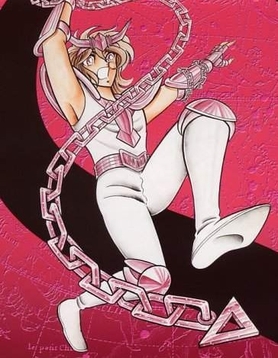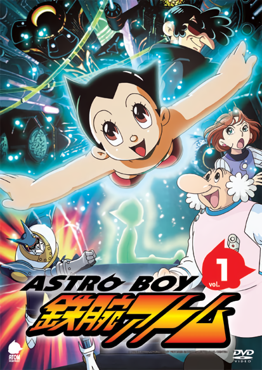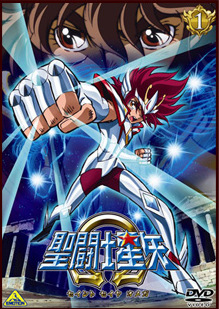
Astro Boy, known in Japan by its original name Mighty Atom, is a Japanese manga series written and illustrated by Osamu Tezuka. It was serialized in Kobunsha's Shōnen from 1952 to 1968. The 112 chapters were collected into 23 tankōbon volumes by Akita Shoten. Dark Horse Comics published an English translation in 2002. The story follows Astro Boy, an android young boy with human emotions who is created by Umataro Tenma after the recent death of his son Tobio. Eventually, Astro is sold to a robot circus run by Hamegg, but is saved from his servitude by Professor Ochanomizu. Astro becomes a surrogate son to Ochanomizu who creates a robotic family for Astro and helps him to live a normal life like an average human boy, while accompanying him on adventures.

Saint Seiya, also known as Saint Seiya: Knights of the Zodiac or simply Knights of the Zodiac, is a Japanese manga series written and illustrated by Masami Kurumada. It was serialized in Shueisha's shōnen manga magazine Weekly Shōnen Jump from 1985 to 1990, with its chapters collected in 28 tankōbon volumes. The story follows five mystical warriors called the Saints who fight wearing sacred sets of armor named "Cloths", the designs of which derive from the various constellations the characters have adopted as their destined guardian symbols. The Saints have sworn to defend the reincarnation of the Olympian goddess Athena in her battle against other gods who want to dominate Earth.
Masami Kurumada is a Japanese manga artist and writer, known for specializing in fighting manga featuring bishōnen and magical boy.

Yu-Gi-Oh! R is a Japanese manga series written by Akira Itō, based on Kazuki Takahashi's Yu-Gi-Oh! manga. The series, which is a spin-off side story to the original manga, was serialized in Shueisha's V Jump magazine between April 2004 and December 2007, and was published in North America by Viz Media.

Astro Boy, known in Japan as Atom, is a fictional superhero and the protagonist of the eponymous franchise. Created by Osamu Tezuka, the character was introduced in the 1951 Captain Atom manga. Astro Boy has appeared in animated television shows and feature film adaptations of its eponymous manga, as well as a live-action TV series, other works by Tezuka, and video games.

Astro Boy, sometimes referred to as New Mighty Atom, is a color remake of the 1960s anime black-and-white series of the same name(s); both series are adapted from the manga series by Osamu Tezuka.

Pegasus Seiya, simply known as Seiya, is a fictional character and the main protagonist in the Saint Seiya manga series created by Masami Kurumada. He is the eponymous protagonist who makes his debut in the first chapter "The Saints of Athena", published in Weekly Shōnen Jump magazine on January 1, 1986. Like most of Kurumada's characters, Seiya's design was inspired in the main character of his previous hit manga Ring ni Kakero, Ryuji Takane.
Shion is a Japanese given name, and may refer to:

Andromeda Shun is a protagonist in the Saint Seiya media franchise, which originated in the manga of the same name, written and illustrated by Masami Kurumada, that subsequently inspired an anime series, soundtracks, OVAs, films, video games, and other collectibles. He is one of the strongest characters in the series, although his gentle disposition and kind nature tend to hold him back from using his full power until he has no other choice but to do so. Shun is also the younger brother of Phoenix Ikki, a fellow Bronze Saint.

Astro Boy is a remake from the 1963 anime series of the same name created by Osamu Tezuka. Produced by Tezuka Productions, Sony Pictures Entertainment Japan, Animax, Dentsu, and Fuji TV, it was directed by Kazuya Konaka, with Marc Handler as the story editor, Shinji Seya designing the characters, Shinji Aramaki and Takeshi Takakura designing the mechanical elements, Keiichirō Mochizuki serving as chief animation director, and Takashi Yoshimatsu composing the music. The anime was created to celebrate the birthdate of Atom/Astro Boy, as well as the 40th anniversary of the original TV series. It kept the same classic art style as the original manga and anime, but was renewed and modernized with more lush, high-quality, near-theatrical animation and visuals, combining the playfulness of the early anime with the darker, more serious and dramatic science fiction themes of the manga and the 1980 series. The anime was broadcast in Japan on Fuji TV from April 6, 2003, to March 28, 2004, every Sunday from 9:30 to 10:00 JST, for a total of 50 episodes, and it was also aired outside of Japan on Kids' WB in the United States and other local broadcasters overseas.
Seiya (星矢) is a masculine name of Japanese origin. It is a common masculine Japanese given name.

Saint Seiya: The Lost Canvas – The Myth of Hades, also known as simply The Lost Canvas, is a Japanese manga series written and illustrated by Shiori Teshirogi. It is a spin-off based on the manga series Saint Seiya, which was created, written and illustrated by Japanese author Masami Kurumada. The Lost Canvas was published by Akita Shoten in the Weekly Shōnen Champion magazine since August 24, 2006, concluding after 223 chapters on April 6, 2011, with twenty-five tankōbon released. Originally envisioned as a comic book whose purpose was to work simultaneously with Kurumada's Saint Seiya: Next Dimension as a multi-angle interpretation of the shared elements of its storyline, which stems from an event mentioned in Kurumada's original Saint Seiya manga; the approach was quickly abandoned, as both works greatly diverged, Kurumada's Next Dimension stayed as the canonical telling of these events, and The Lost Canvas as a separate alternate retelling. The story takes place in the 18th century, and focuses on how an orphan known as Tenma becomes one of Athena's 88 warriors known as Saints and finds himself in a war fighting against his best friend Alone who is revealed to be the reincarnation of Athena's biggest enemy, the God Hades.

Saint Seiya: Next Dimension – Myth of Hades is a Japanese manga series written and illustrated by Masami Kurumada. It is the canonical sequel to the manga series Saint Seiya by Kurumada, while also serving as a prequel to the events presented in it. The main plot is set in the 18th century during the previous "Holy War" between the goddess Athena and the god Hades, and centers on the battles between each deity's warriors who are known as the Saints and the Specters, respectively, during that era. It is published by Akita Shoten in the weekly magazine Weekly Shōnen Champion at irregular dates.

The winged, divine horse Pegasus has been a prominent figure in modern popular culture.

Saint Seiya Omega is an anime series produced by Toei Animation. It is a spin-off of the Saint Seiya anime series written and illustrated by Masami Kurumada, produced in commemoration of the 25th anniversary of the franchise. The series began broadcasting in Japan on TV Asahi on April 1, 2012.

Truck-kun is an Internet meme that refers to a common trope used in the isekai genre of anime and manga, in which characters are transported to other worlds. Typically, the protagonists of the isekai anime or manga are sent to these worlds via reincarnation after death, though recently many isekai works have featured characters being transported upon being hit and killed by a truck. After several isekai works featured this as a means to kill their characters, a meme claiming the existence of a character named "Truck-kun" spread. It is purported Truck-kun's role is to kill people in their original world and subsequently send them to a new one.












